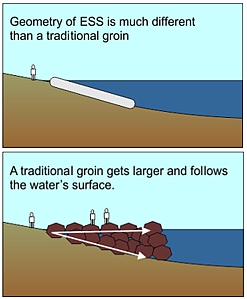No. But to the uninitiated, the general appearance may seem similar. This is a superficial likeness as you will see. Some in the past have described it “looking like an underwater groin”. It is not.
“How” the ESS stabilizer system actually works is substantially different from the traditional rock groins seen in most locations, and in particular, how the ESS reacts with current flow and wave energy.
Our systems absorb and redirect, where “rock piles” reflect all the energy back onto the sandy bottom causing instability and sand loss.
ESS stabilizer systems are shore-perpendicular, low-profile structures that are placed in configurations similar to that of traditional groins. However, the differences between stabilizers and groins are profound in both geometry and effect. ESS stabilizer systems consist of concrete grout-filled geotextile tubes. The rounded shape of the stabilizers reduce the amount of wave reflection and turbulence created when significant waves reach the shore.

Wave reflection and turbulence are primary reasons that structures such as seawalls, groins, and revetments damage adjacent property and scour out their own foundations.
The ESS is NOT an underwater groin system

The other unique geometric aspect of the EnviroShore Systems stabilizers is that they follow the bottom profile and taper down in size as they extend into the water. This is opposite of the geometry of groins that become larger in size and follow the water surface as they extend seaward (see image below).
The primary utility of tapering and hugging the bottom is that these structures are essentially permeable with respect to the littoral (longshore) movement of sediments. Traditional groins are impermeable, blocking and rerouting the littoral drift.
The permeability of EnviroShore Stabilizer (ESS) technology is a reason that monitoring surveys have found no downstream losses of beach or bluff.
A favorable effect of the low-profile geometry of ESS stabilizer systems is that they force additional shoaling of waves before reaching the beach. This, along with their less reflective nature, creates a low energy strand of beach. Since fast water picks up sand and slow water drops its load, the low energy beach will be the most likely place where deposition of suspended sediment load will occur.

Equally Important for long term success, ESS stabilizer systems are successful at retaining the natural slope of the beach platform.
Scouring at and adjacent to traditional structures, like rock groins and seawalls, create an artificially deepened nearshore which subjects those areas to greater wave energy.
Scouring also occurs on natural and artificially nourished beaches. The material loss caused by wave action begins at the trough between shore and bar, progressing shoreward. If the storm duration is long enough for this deepening to reach the shore, losses of the beach platform and bluff occur.
The orientation of ESS stabilizer systems resists this deepening by helping retain the natural slope of the beach and nearshore.
Professionals in many fields are finding that “the more a man-made solution imitates natural forms, the more permanent and positive will be the results”.
EnviroShore Systems, Inc.

